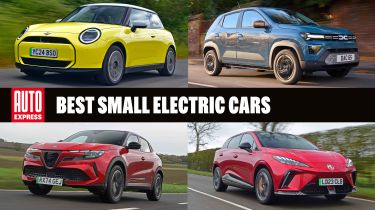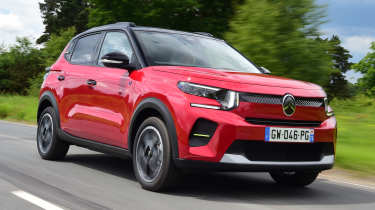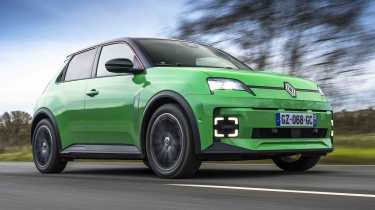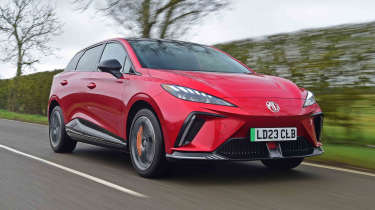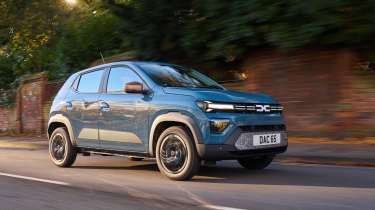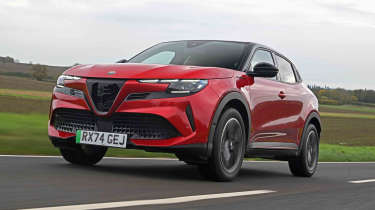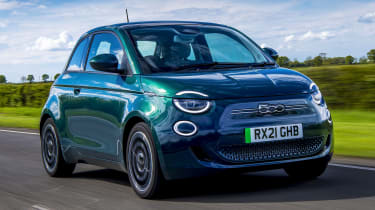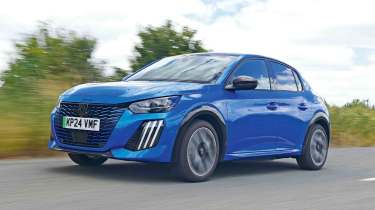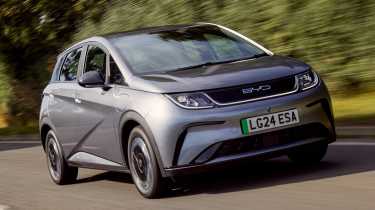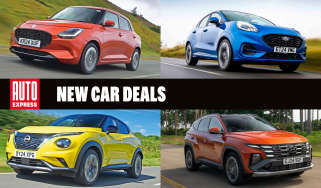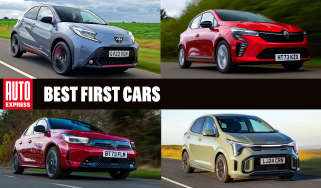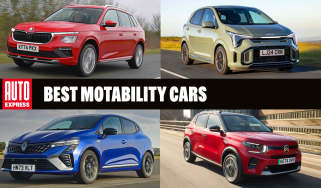Best small electric cars to buy 2025
There are electric superminis and hatchbacks cropping up everywhere these days, but these are our favourite small electric cars on sale right now
Small cars are a firm favourite in the UK; they perfectly suit our cosy country roads, as well as the increasingly congested streets in our towns and cities. Some of the first EVs to arrive in Britain were also pretty small, such as the original Nissan Leaf and Renault Zoe, the forward-thinking BMW i3 and the Reva G-Wiz – although the less said about that the better.
Since those pioneers arrived the number of electric cars available in the UK has skyrocketed. A lot of them are family SUVs and executive saloons, but a good many are small cars including city cars, hatchbacks and crossovers. More than a few of the entries on this list are also among the cheapest electric cars on sale.
You could argue that electric cars make most sense when used for short trips in urban areas. Assuming that you have somewhere to charge at home or at a place of work, a small EV with a range of around 200 miles is a fantastic option as a low mileage first or second car. Even if you can’t charge at home, you might only need to find a public charging point once a week or so, with the kind of ranges currently on offer.
Beyond that, the brisk acceleration, near silent running and beautifully simple driving experience make these small electric cars very attractive. So, without further ado, here are our top 10 favourite small electric cars, listed in descending order.
1. Citroen e-C3
- Prices from £22,000
- WLTP combined battery range: up to 199 miles
| Pros | Cons |
|
|
The Citroen e-C3 won our Car of the Year 2024 title for good reason. As well as simply being a talented little car in its own right, it was also a sign that the EV market isn’t limited to 50-grand, two-tonne SUVs. The e-C3 starts at under £22,000 and is as easy to live with, to manoeuvre around town, and to park as any other supermini.
There are of course some compromises to get an EV at this level, although not as many as you get with the tinier and even cheaper Dacia Spring or Leapmotor T03. You can’t get an e-C3 with a heat pump for instance, so the official 198-mile range is subject to the ambient temperature, and there are more refined EVs out there.
But on the other hand, the ride quality and squashy seats make the e-C3 comfortable even on poorly surfaced roads (so that’s comfortable almost everywhere), the performance is plenty brisk enough for most people (0-62mph in 11 seconds), and useful features such as Apple CarPlay and Android Auto, and cruise control, are standard. The top-spec Max comes with even more for only another few grand – still less than a lot of petrol and hybrid superminis.
2. Renault 5
- Prices from £23,000
- WLTP combined battery range: up to 248 miles
| Pros | Cons |
|
|
Small cars, electric or otherwise, don’t come much more stylish than the Renault 5 E-Tech. Sorry, MINI and Fiat 500, but you don’t stand a chance parked alongside a 5; cutesy doe-eyed late-50s inspired pastel-coloured hatchbacks are out, chic trapezoidal 1970s lines and eye-popping psychedelic colour schemes are in.
Luckily, the 5 has more to it than just good looks. It’s also priced well, with a range starting at £23,000 for a 118bhp, 40kWh car in Evolution trim, and topping out with a 148bhp, 52kWh model in Iconic Five spec. The sweet spot is probably somewhere in the middle: Techno trim with the punchier motor and larger battery (which come as a pair), to get the quicker 7.9-second 0-62mph time and longer 248-mile range.
All models are well equipped – you still get a 10.1-inch touchscreen, 18-inch alloy wheels and a set of stylish fabric-trimmed bucket seats, even on the Evolution. The 5’s good to drive too, not quite topping the MINI for nimbleness but getting close, and riding with the maturity of a larger car, despite a town-friendly turning circle. Rear-seat passengers will find it a bit cramped back there, but the trade-off is a decent-sized boot.
3. MG4
- Prices from £27,000
- WLTP combined battery range: up to 323 miles
| Pros | Cons |
|
|
The MG4 isn’t a small car in the sense of some other cars here, but as a proper, usable electric car that’s no bigger than a Ford Focus, it’s still among our favourite models. It’s been on sale since 2022 and its appeal hasn’t diminished in that time, with a wide range of variants on offer, all promising competitive performance and range figures.
Prices now start at around £27,000, which is a little more than at launch, but even that base model with its 49kWh battery pack gets you 218 miles of range. Things quickly go up from there – Long Range models begin at under £30k and get a 64kWh pack for up to 281 miles, while the Trophy Extended Range at around £36,500 lifts that to 77kWh and 323 miles. That one also gets a 242bhp rear motor and sprints to 62mph in 6.1 seconds.
There’s also a high-performance XPower model, but really our preference is somewhere in the middle, where the MG4 offers great value. It’s also genuinely good to drive, being easygoing in town but quite nimble and playful on B-roads. EV architecture means pretty decent interior space, though the infotainment screen could be better to use.
4. Dacia Spring
- Prices from £15,000
- WLTP combined battery range: up to 140 miles
| Pros | Cons |
|
|
Dacia is one of the last holdouts of truly affordable motoring, so it’s no surprise that its first electric car, the Dacia Spring, is the cheapest ‘proper’ electric car (in other words, not a quadricycle like the Citroen Ami) on the market. It starts at just under £15,000, and even if you’re completely reckless with the options list on the top-spec, more powerful model, it is still impossible to spend more than £19,500.
There are just two trim levels: Expression and Extreme. Both get a 26.8kWh battery pack, and while the Expression has 44bhp and 64bhp electric motor options, the Extreme just gets the 64bhp motor. Range is 140 miles for the lower-powered car and 142 miles for the brisker of the pair. You’ll probably want that sprightlier model, which trims the 0-62mph time down from a yawning 19.1 seconds to a comparatively white-knuckle 13.7 seconds.
The Spring’s small size and bargain basement price compromise things such as rear legroom or the quality of the plastics surrounding you, and the doors close with a bit of a clang, but it’s a doddle to thread around town thanks to its narrow width and a tight turning circle. The ride just about does the job and the skinny tyres keep road noise to a minimum. And as well as the low price, that tiny battery won’t cost much to charge; no wonder it’s one of the cheapest cars in the UK to run.
5. MINI Cooper
- Prices from £30,100
- WLTP combined battery range: up to 247 miles
| Pros | Cons |
|
|
The electric MINI is now technically in its third generation, following the model that arrived in 2019 and bowed out in 2024, and the short run of MINI Es that BMW produced between 2009 and 2010 to help it get a handle on electric power. That’s plenty of experience then to ensure the latest model hits the mark.
This time called the MINI Cooper, it’s available in 181bhp, 36.6kWh Cooper E and 215bhp, 49.2kWh Cooper SE versions – plus a recently introduced 258bhp and 49.2kWh John Cooper Works Electric Sport model. The look is all new (or at least, as new as a design with its roots in the 1950s can be considered) and it’s still pretty pokey in the back seats and the boot, but the peppy performance and fun handling are still present and correct.
That’s just as well, because it falls down on the value side somewhat. You’ll pay more than £30k for an entry-level Cooper E in Classic trim with just a 185-mile range, making the £23k, 193-mile Renault 5 E-Tech look like a bargain. If you want a more competitive 247-mile range then the cheapest Cooper SE is more than £35,000. Expense aside though, the MINI remains a desirable product, electric or not.
6. Alfa Romeo Junior
- Prices from £34,000
- WLTP combined battery range: up to 255 miles
| Pros | Cons |
|
|
It’s been a while since Alfa Romeo offered a smaller car, with the Mito supermini becoming extinct back in 2018. The new Alfa Romeo Junior is a bit bigger than that model, and shares its underpinnings and basic structure with cars such as the Jeep Avenger and Peugeot 2008. For us, though, it’s the best car on that widely used platform, so deserves its spot in this list.
Part of that is because the Alfa seems to have been set up by people who enjoy driving, so while performance is a little different from its Stellantis equivalents (0-62mph takes nine seconds in the basic Elettrica) the handling’s much more fun, and the controls give you a better idea of what’s going on at ground level.
Alfa also offers the 276bhp Junior Veloce, similar underneath to the Abarth 600e. This scrabbles to 62mph in under six seconds, and is a bit of a hoot, although at more than £42,000 it’s priced among some pretty desirable petrol hot hatches. The smart money then is probably on the Elettrica, with prices starting around £34,000 and a range of 255 miles.
See our Alfa Romeo Junior deals
7. Fiat 500e/Abarth 500e
- Prices from £25,000
- WLTP combined battery range: up to 199 miles
| Pros | Cons |
|
|
A smooth, silent, zero-emissions powertrain makes perfect sense in a city car as you want something agile and zippy when navigating tight and congested streets. Fiat clearly had the same brainwave, as the latest iteration of its best-selling Fiat 500e is fully electric and we like it so much it won our City Car of the Year award in both 2021 and 2022.
While the 500 is just about capable of handling shorter motorway trips, it’s in the sprawling chaos where this car really shines. It’s easy to park, the steering is light, the ride is comfortable for a car of this class, and it’s capable of one-pedal driving.
Entry-level models have a 118-mile thanks to a 24kWh battery, but if you spring for the 42kWh battery, it boosts the dinky EV’s range up to a much more usable 200 miles. Small batteries also mean quick charging times; a 10 to 80 per cent top-up from most rapid chargers takes just half an hour.
Hop inside and, no matter which trim level you choose, you’re greeted by a thoroughly modern cabin featuring tech like a 10.25-inch central touchscreen, Apple CarPlay, Android Auto and a fully digital driver’s display. The 500 also has level 2 autonomous driving capabilities – this allows the car to adjust acceleration and braking while remaining within its designated lane.
If you want to feel the wind in your hair you get a convertible version called the 500c, or there’s the souped-up Abarth 500e with 150bhp on tap and plenty of character.
8. Peugeot E-208
- Prices from £30,000
- WLTP combined battery range: up to 254 miles
| Pros | Cons |
|
|
Related to the Alfa Romeo Junior elsewhere on this rundown, the Peugeot E-208 takes the form of a conventional supermini rather than a small SUV – and it’s one of our favourite electric superminis. Good looks are backed up by a fine drive and plenty of kit. It can’t quite match newcomers like the Renault 5 E-Tech, but the E-208 still has plenty going for it.
Prices begin a smidge under £30,000 for an E-208 in Allure spec, with a 134bhp electric motor up front and a 50kWh battery underneath. Unlike some rivals, there’s no significant step up in battery size as you spend more, but Peugeot does offer a 154bhp motor with a 51kWh pack for about £800 more. We suggest you take that option, since the seemingly tiny step up in capacity allows for a 248-mile range compared with 217 miles.
Conversely, the extra power doesn’t make a blind bit of difference in terms of performance: 8.1 seconds from 0-62mph for the lower-power car, and actually a tenth slower for the 154bhp model. More meaningful is the E-208’s modern, high-quality interior design, refinement, and driving characteristics that feel at home on the motorway as well as in town.
9. BYD Dolphin
- Prices from £26,200
- WLTP combined battery range: up to 265 miles
| Pros | Cons |
|
|
China has carved out a niche for itself in the European market, offering great-value electric cars that mix size, equipment and price in a way more familiar brands sometimes struggle to match. The BYD Dolphin is one of those cars, roughly the size of a small family car but with a price that’s closer to some superminis.
That starting price is currently around £26,000, which gets you a 45kWh battery pack good for 211 miles, but step up to the range-topping Dolphin Design and the range swells to 265 miles. The Design is also quickest, getting a 201bhp motor and seven-second 0-62mph time, but don’t expect any fireworks in the driving experience – the relatively soft suspension that soaks up bumps admirably in town means the Dolphin is unsettled on a country road.
The interior has the usual BYD quirkiness, with quite an organic look to the dashboard, reasonable quality and a rotating touchscreen infotainment system. When you’re not playing “screen goes up, screen goes down”, it functions pretty well, and the Dolphin’s near-monobox shape means plenty of interior space and a decent boot.
10. Leapmotor T03
- Prices from £16,000
- WLTP combined battery range: up to 165 miles
| Pros | Cons |
|
|
Electric cars are expensive, right? Well, every rule has its exceptions, and along with the Dacia Spring, the Leapmotor T03 bucks the trend of EVs costing far more than combustion-engined cars. A starting price of around £16,000 means it costs a little more than the Spring, but otherwise the T03 is one of the cheapest cars anywhere on the market, let alone among EVs.
It serves much the same purpose as the Dacia Spring. This Chinese EV, backed by Stellantis, the company behind the likes of Peugeot, Citroen and Vauxhall, is aimed primarily at urban use, with modest performance and a relatively low range. That said, its 165-mile figure is higher than that of the Spring, going some way to justifying the extra money.
The T03 also feels a bit more substantial, with higher equipment levels and an interior that feels more plush. 48kW charging is generous for a small EV like this, too. A 12-second 0-62mph time isn’t bad, and it rides and handles better than you might expect from something that looks taller than it is wide.
See our new Leapmotor T03 discounts
Best small electric cars: prices and ratings table
| Best small electric car ranking | Model | Prices from | Ranking for range, charging & running costs (out of 5) | Overall Auto Express star rating (out of 5) |
| 1 | Citroen e-C3 | £22,000 | 5 | 5 |
| 2 | Renault 5 | £23,000 | 4 | 4.5 |
| 3 | MG4 | £27,000 | 4.2 | 4.5 |
| 4 | Dacia Spring | £15,000 | 3.5 | 4.5 |
| 5 | MINI Cooper | £30,100 | 3.5 | 4 |
| 6 | Alfa Romeo Junior | £34,000 | 4 | 4 |
| 7 | Fiat 500e/Abarth 500e | £25,000 | 4 | 4 |
| 8 | Peugeot E-208 | £30,000 | 3.8 | 3.5 |
| 9 | BYD Dolphin | £26,200 | 4 | 4 |
| 10 | Leapmotor T03 | £16,000 | 4 | 4 |
Searching for a bargain? These are the cheapest electric cars...

